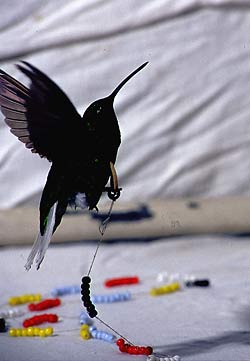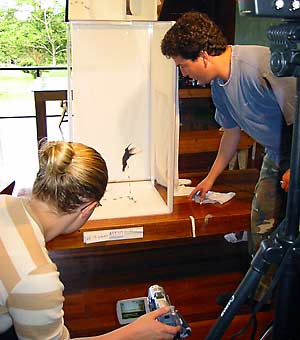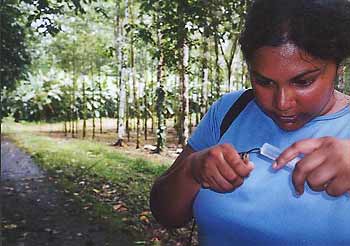UC Berkeley Press Release
Hummingbirds lose power at high altitudes
BERKELEY – Hummingbirds aren't known for their power-lifting prowess. But researchers nevertheless put nearly 1,000 Peruvian hummers through lifting trials and flight tests over a two-year stretch in order to find out how their flying abilities are affected by the lower oxygen and thin air of higher elevations.
 A Mountain Velvetbreast hummingbird (Lafresnaya lafresnayi) strains to lift a string of beads in a test of its maximum power output. (Jim Hamilton photo) |
The results, which appeared this week in the Proceedings of the National Academy of Sciences (PNAS) Online Early Edition, show a clear decline in hummingbirds' lifting ability with altitude, not unlike that seen in athletes competing at high elevations.
What this means for hummingbirds is less reserve power for the bursts of flight needed to chase off competitors or escape from predators, said researchers from the University of California, Berkeley, and the California Institute of Technology.
"The costs of hovering flight are the same across elevations because hummingbirds compensate by having larger wings and by having a larger stroke amplitude," said study leader Douglas Altshuler, a postdoctoral fellow at Caltech. "However, that compensation doesn't come for free. They don't have as much excess power at high elevations as they do at low elevations."
"The power margin decreases at higher elevation, primarily because the stroke amplitude of the wing increases to account for the thinner air," added coauthor Robert Dudley, a professor of integrative biology at UC Berkeley and Altshuler's advisor when both were at the University of Texas, Austin. "If the bird can only flex its wings through a maximum of 180 degrees, that leaves less power available for other things, like ascending and chasing."
Altshuler noted that the many quick movements hummingbirds make would be impaired by a loss of marginal power at high elevations.
"When you spend a lot of time watching hummingbirds, you realize they engage in an amazing suite of maneuvers, above and beyond hovering at flowers for nectar or insects," he said. "They are constantly using much more mechanical power to do other interesting things, such as competing with other males and courting females."
 Doug Altshuler and Earthwatch volunteer Suzanne Bader videotape a hummingbird power-lifting test in his field laboratory in Costa Rica. (Doug Altshuler photo) |
Their mating display, for example, consists of repeated vertical ascents and power dives. And they engage in fast forward flight chases to kick other males off their territory.
It's not surprising, then, that the loss of power and maneuverability at higher elevations affects their social interactions and determines which of them dominates the flower territory. Althshuler showed in his Ph.D. dissertation that "there's a very strong correlation at high altitudes between maximum power output and how much of that excess power is available, and which birds dominate, which birds control the territory," he said.
The PNAS paper also includes the most complete family tree of hummingbirds ever produced, representing 75 of the approximately 337 known species and most of the known genera. Hummingbirds are found only in the Americas, but occupy many niches from the tip of southern Chile to Alaska.
"To correlate wing characteristics with power margin at different elevations, you have to account for the phylogeny -- the family tree that shows you how species are related to one another," said coauthor Jimmy A. McGuire, assistant professor of integrative biology at UC Berkeley. "Since we see an inverse correlation between power margin and elevation, we have to make sure it's true across a wide variety of species."
McGuire obtained DNA samples from museum specimens, relying mostly upon the tropical bird collections of the Museum of Natural Science at Louisiana State University in Baton Rouge, and analyzed two nuclear and one mitochondrial gene from each species. Though only 75 species are represented in the hummingbird family tree published in PNAS, he actually has phylogenetic data representing approximately 275 of the known species.
The researchers set out to answer some puzzling questions about hummingbird flight, which is among the most power-hungry activities of any animal, bird or otherwise. Altshuler and Dudley had shown earlier that hummingbirds living at higher elevations have larger wings relative to their weight, presumably to create more lift in the thinner air. Further experiments showed that hummers sweep their wings through a bigger angle, the so-called "stroke amplitude," to compensate further.
So if hummingbirds compensate to make hovering easy at higher elevations, are there no costs involved in moving upslope? If not, why don't all hummingbirds move higher, where there are more flowers and less competition from other birds and insects? Mountain flowers even appear to have made themselves more attractive to hummingbirds, perhaps to lure them to higher elevations, Altshuler noted.
"That was a conundrum," McGuire said. "It didn't make sense that there is no cost to being at higher elevations."
The new study by Altshuler, Dudley and McGuire shows the true cost is in the power margin that lets hummers do anything beyond basic hovering.
To get sufficient data, Altshuler needed lots of hands in the field, so he decided to seek help from the Earthwatch Institute and use their eco-volunteers to net hummingbirds. He conducted his field experiments over the course of seven expeditions between 1997 and 1999, leading groups at lower elevations near the Amazon and into the mountains around Cuzco, Peru, from 400 meters (1,300 feet) elevation to 4,300 meters (14,100 feet).
 Earthwatch volunteer Vanitha Sivarajan feeds a hummingbird netted in Costa Rica. (Doug Altshuler photo) |
"We set up huge lines of mist nets, one after another -- up to 30 -- and the job of the Earthwatch volunteers was to go through the nets, take all the birds out, release the non-hummingbirds, and bring the hummingbirds back to us," he said. "Netting birds is very satisfying, and the volunteers just loved it; they got to touch and handle the birds all the time. They were great people, amazing people."
In his field laboratory, Althshuler put the hummers through their paces, then released them. After weighing and measuring wing size, he filmed them hovering inside a Plexiglas cube to obtain wing beat frequency and stroke amplitude, from which he could calculate the power exerted in normal hovering.
The second experiment, however, measured the maximum power the birds' muscles were capable of. In a setup originally developed by Dudley and former post-doc Peng Chair, he attached a string of evenly spaced, color-coded beads to the bird's body and filmed the bird as it tried to lift the string off the floor of the cage.
"When you release them from the floor of the chamber, they fly up to escape, lifting progressively more weight," Altshuler explained. "This gives us in a single test their maximum lift, because they go as high as they can trying to escape. And then they tend to hover briefly, a second or less, and at that moment, we get a snapshot of them with their muscles working as hard as they possible can."
With full data from 347 of nearly 1,000 captured hummingbirds, a sample representing 43 species, Altshuler was able to show that, whereas body mass and power output increase with elevation in hummingbirds, the power margin goes down.
"Higher elevations are an appealing niche, and hummingbirds have headed up there, but there are challenges," Altshuler said.
The other important aspect of the paper, a hummingbird family tree encompassing three times the number of species as earlier genealogies, showed a few surprises, too, said McGuire, a specialist in phylogenetic analysis of animal groups. While much of the tree confirms earlier results, the world's largest hummingbird, the giant hummingbird (Patagona gigas), stood out on its own, perhaps indicating that it has taken its own evolutionary path away from the other hummingbirds. It grows as large as 26 grams -- nearly an ounce and almost twice as large as the next largest bird at 15 grams.
Also, two boldly colored hummingbirds -- the crimson topaz, Topaza pella, and the white-necked Jacobin, Florisuga mellivora -- thought to be members of a group dubbed "the Mangoes," seem to be unrelated to the other Mangoes. They also seem to be more primitive than even the drab hermits, regarded as the most primitive of the hummingbirds.
"If these species turn out to be the earliest, deepest lineage of hummingbirds, it would throw into question the presumed phylogeny," McGuire said.
The work was supported by the Earthwatch Institute of Maynard, Mass., and the National Science Foundation.

